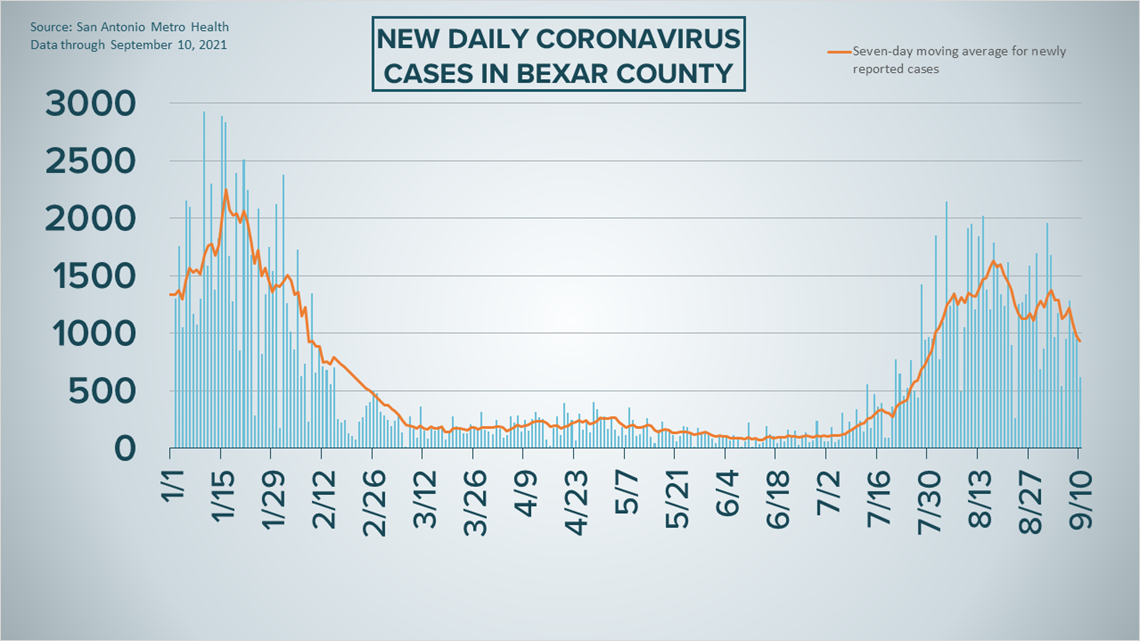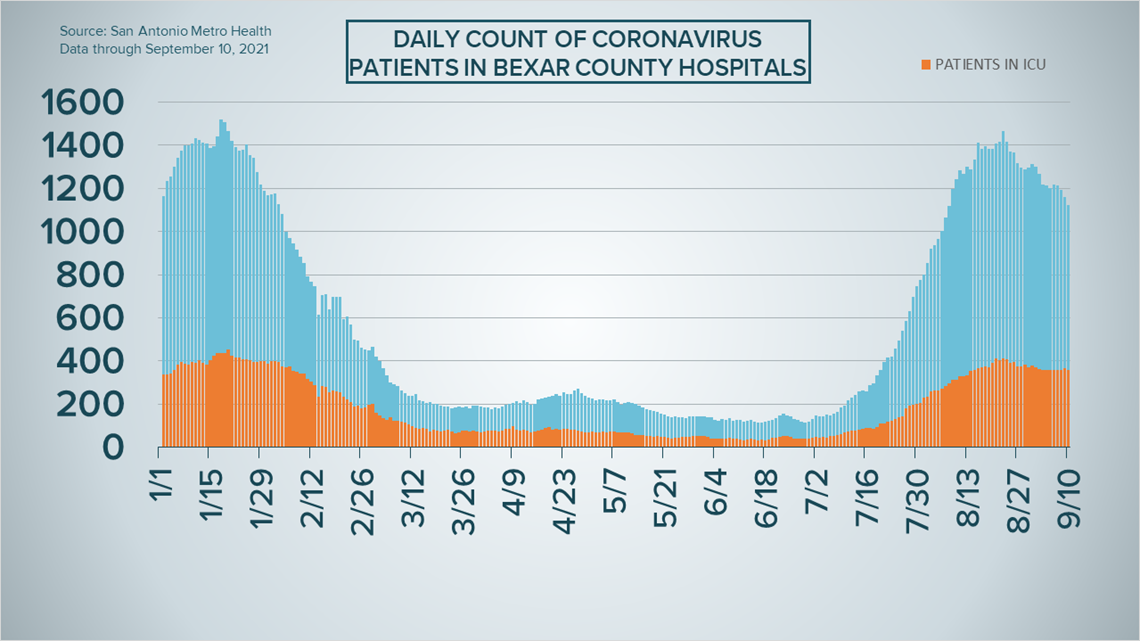SAN ANTONIO — Need a vaccine appointment? Click here for the latest information on local vaccine distribution with our ongoing Vaccine Tracker.
Latest Coronavirus Numbers
Here are the latest numbers reported by Bexar County and state officials:
Bexar County (data as of Friday, Sept. 10):
- 620 additional COVID-positive cases were reported Friday; the seven-day moving average of new cases is 934 per day. The total number of cases rose to 296,573.
- The county's death toll rose to 4,035 on Friday after 18 new deaths were reported.
- 140 new patients with COVID-19 were admitted to San Antonio area hospitals in the last day. As of Friday, 1,121 Bexar County residents are currently hospitalized, including 24 children with COVID-19. 249 patients are on ventilators, while 358 are in intensive care.
Texas (data as of Friday, Sept. 10):
- 23,619 cases were reported Friday, including 19,050 new confirmed, 4,220 new probable, and 349 backlogged cases. More than 3.787 million Texans have been diagnosed with COVID-19 since the pandemic began.
- 400 additional deaths were reported, raising the statewide death toll from virus complications to 58,332.
- 13,422 lab-confirmed COVID-19 patients were hospitalized across Texas, as of Friday; that includes 306 pediatric COVID-19 patients in hospitals across the state. The state has 432 adult ICU beds and 77 pediatric ICU beds available.
More county case information is available through the Texas Department of Health Services COVID-19 dashboard.




Vaccine Progress in Bexar County
The following numbers are provided by San Antonio Metro Health. A full breakdown can be found here.
- 1,435,702 Bexar County residents have received at least one dose of the coronavirus vaccine, representing 85.8% of the county's population eligible to receive a vaccination.
- 1,162,982 Bexar County residents are fully vaccinated, representing 69.5% of the county's population eligible to receive a vaccination.
The CDC states that "when a high percentage of the community is immune to a disease (through vaccination and/or prior illness)," that community will have reached herd immunity, "making the spread of this disease from person to person unlikely."
The City of San Antonio breaks down the vaccination rates by zip code on Metro Health's Vaccination Statistics page.
Across Texas, 14.06 million residents are fully vaccinated, according to the Texas Department of State Health Services. In total, the state has administered 29.612 million vaccine doses, as of September 9. Texas is in the middle of the pack among the rest of the states, with between 44 to 60 percent of its population fully vaccinated, as of September 8:


Progress and Warning Indicators
Coronavirus symptoms
The symptoms of coronavirus can be similar to the flu or a bad cold. Symptoms include fever or chills, cough, shortness of breath or difficulty breathing, fatigue, muscle or body aches, headache, new loss of taste or smell sore throat, congestion or runny nose, nausea or vomiting, and diarrhea, according to the Centers for Disease Control.
Most healthy people will have mild symptoms. A study of more than 72,000 patients by the Centers for Disease Control in China showed 80 percent of the cases there were mild.
But infections can cause pneumonia, severe acute respiratory syndrome, kidney failure, and even death, according to the World Health Organization. Older people with underlying health conditions are most at risk.
Experts determined there was consistent evidence these conditions increase a person's risk, regardless of age:
- Chronic kidney disease
- COPD (chronic obstructive pulmonary disease)
- Obesity (BMI of 30 or higher)
- Immunocompromised state (weakened immune system) from solid organ transplant
- Serious heart conditions, such as heart failure, coronary artery disease, or cardiomyopathies
- Sickle cell disease
- Type 2 diabetes
- The CDC believes symptoms may appear anywhere from two to 14 days after being exposed.
Human coronaviruses are usually spread...
- Between people who are in close contact with one another (within about 6 feet).
- Through respiratory droplets produced when an infected person coughs, sneezes or talks. These droplets can land in the mouths or noses of people who are nearby or possibly be inhaled into the lungs.
- Some recent studies have suggested that COVID-19 may be spread by people who are not showing symptoms.
Help stop the spread of coronavirus
- Get vaccinated
- Wear a mask
- Stay home when you are sick.
- Eat and sleep separately from your family members
- Use different utensils and dishes
- Cover your cough or sneeze with your arm, not your hand.
- If you use a tissue, throw it in the trash.
Find a Testing Location
City officials recommend getting a COVID-19 test if you experience fever or chills, cough, shortness of breath or difficulty breathing, fatigue, muscle or body aches, headache, new loss of taste or smell, sore throat, congestion or runny nose, nausea or vomiting, or diarrhea.
Here's a Testing Sites Locator to help you find the testing location closest to you in San Antonio.

